
This first figure shows development
of a valley breeze. This is a circulation that forms early in the
day when the sun's rays are striking the mountain sides more directly
than the level ground in the valley. The mountain sides will
begin to warm more rapidly that the valley floor (the mountain slopes
aren't warmer than the valley just warming more quickly because the
incident sunlight is more direct). Air in contact with the
mountain warms and becomes bouyant and creates an upslope breezs.
Wind begins to blow from the valley up the mountain sides to replace
the rising air.
At night the ground will cool more quickly and becomes colder than the air above.
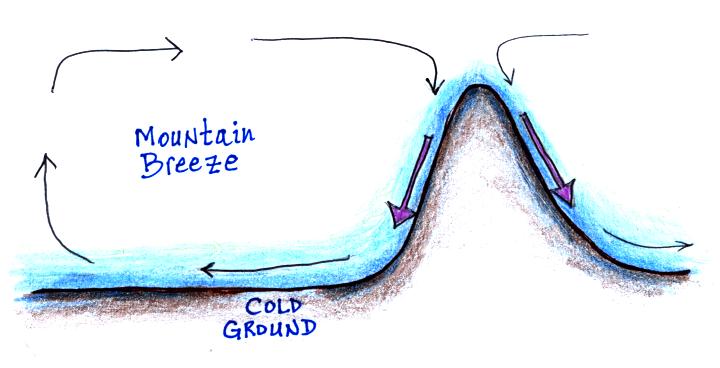
At night the ground will cool more quickly and becomes colder than the air above.

Air in contact with the ground
cools. This now denser air slides downslope and moves into the
valleys. Since the surface winds blow from the mountain into the
valleys this is called a mountain breeze.
The term katabatic wind is a more general term for a high density, gravity driven, downslope or drainage wind. A katabatic wind can affect a much larger area than a simple mountain breeze.
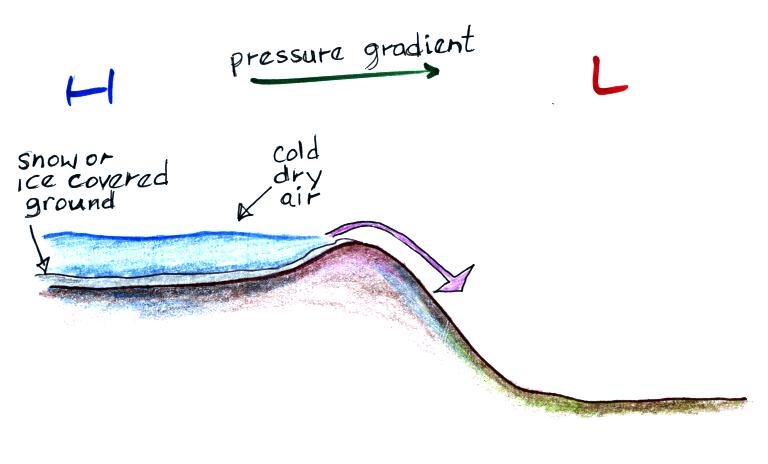
Katabatic winds often originate over high elevation snow covered
plateaus where stagnant air can become quite cold and also very
dry. A large scale pressure pattern can then move the air away
from its source region. When the downward moving air is confined
by canyon walls, winds can reach hurricane force. Though
generally cold, katabatic winds can also be warm or hot. This is
because as the air moves downhill and is compressed it warms.
The mistral is a strong, cold, and dry, katabatic wind that affects SE France. In this case the downward flow of the air is enhanced by a large scale pressure pattern. The winds can persist for several days. (these two figures are from a Wikipedia article on the mistral)
A chinook (foehn) wind is a warm dry downslope wind.
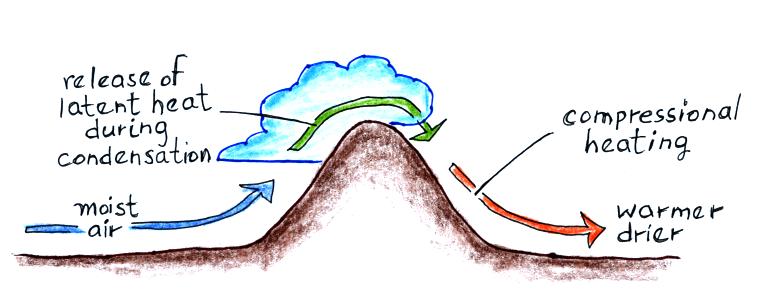
Warming is due to release of latent heat during cloud formation as moist air flows up and over a mountain range and by compressional heating on the downslope side of the mountain (note we're really just revisiting the "rain shadow effect" that was discussed in Lecture 20).
Chinook winds can produce record setting changes in weather and temperature (these records are from a Wikipedia article on Chinook winds)
The Santa Ana winds are probably the best known of the regional winds we will be discussing. These are warm (hot) dry winds that originate in the high deserts of the Great Basin and blow southwestward across southern California usually in the fall. They are often associated with devastating wild fires.

The wind circulation that develops when high pressure forms over the Great Basin causes some of the cool (cold) dense air to begin to move downhill toward the coast. As the air descends it is compressed and warms (this is the main source of warming). Winds pick up speed when the air is funneled through canyons near the coast. There is often a marked improvement in visibility in the Los Angeles basin when the Santa Ana winds are blowing (assuming of course no wildfire activity).
As mentioned earlier the Santa Ana winds can quickly turn a relatively small wildfire into a catastrophic fire event. 9 people were killed, 85 injured, at least 1500 homes and 500,000 acres were burned during a series of wildfires in Southern California in October, 2007. Drought and the Santa Ana winds were major contributing factors.
In addition to being a fire danger, winds in desert regions like southeastern Arizona can produce dust storms.

This is a particularly good photograph of a dust storm approaching a military camp in Al Asad, Iraq. The picture was taken just before nightfall on April 27, 2005 by Corporal Alicia M. Garcia (US Marine Corp.). Dust or sand storms like this are often called a haboob.
Dust storms are a particular hazard to highway travel because they can reduce visibility to near zero very rapidly.
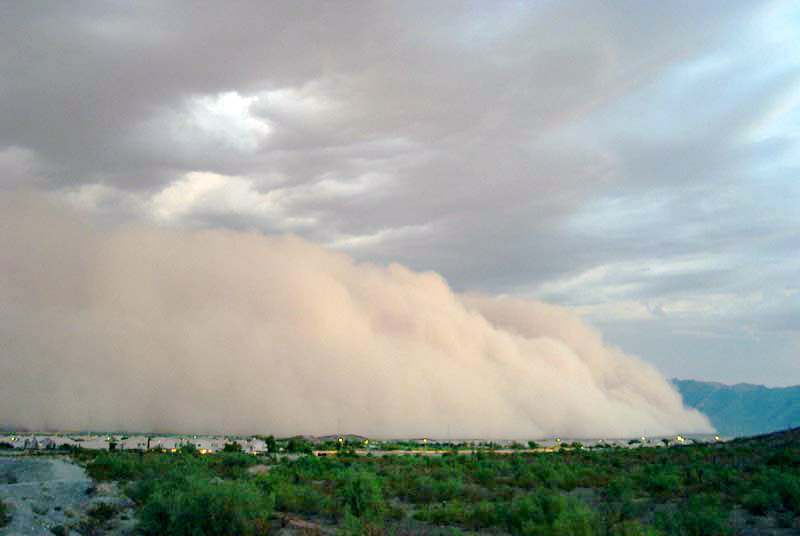
This photograph, taken in August 2003, shows a dust cloud moving into the Pheonix area (Ahwatukee) in August, 2003. The dust probably marks the leading edge of cold downdraft winds that are moving outward from underneath a thunderstorm (the gust front).
Here are some suggestions about what you should do if you are caught in a dust storm.
The term katabatic wind is a more general term for a high density, gravity driven, downslope or drainage wind. A katabatic wind can affect a much larger area than a simple mountain breeze.

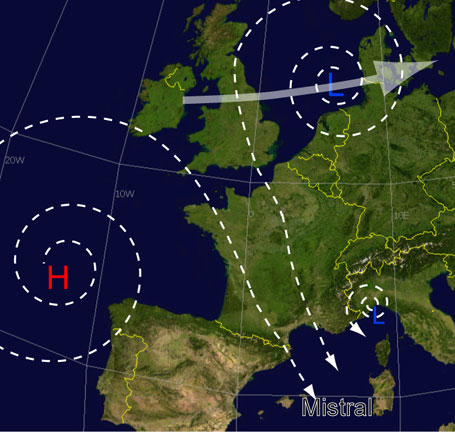 |
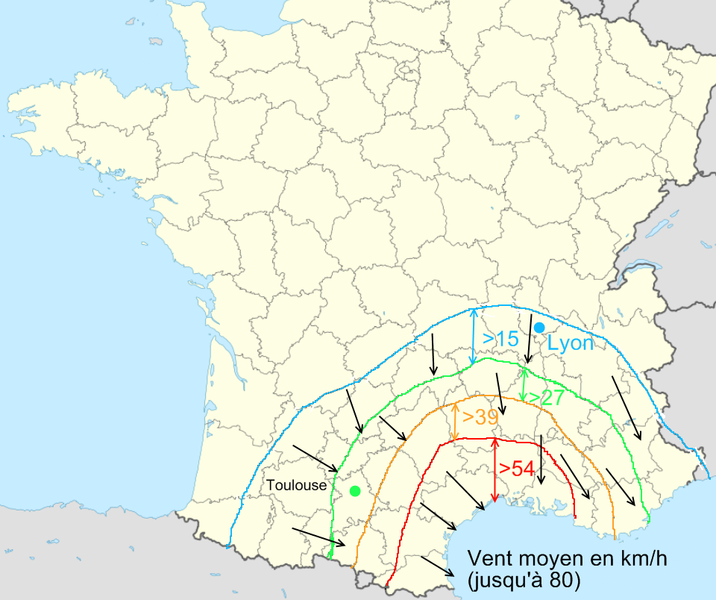 |
The mistral is a strong, cold, and dry, katabatic wind that affects SE France. In this case the downward flow of the air is enhanced by a large scale pressure pattern. The winds can persist for several days. (these two figures are from a Wikipedia article on the mistral)
A chinook (foehn) wind is a warm dry downslope wind.

Warming is due to release of latent heat during cloud formation as moist air flows up and over a mountain range and by compressional heating on the downslope side of the mountain (note we're really just revisiting the "rain shadow effect" that was discussed in Lecture 20).
Chinook winds can produce record setting changes in weather and temperature (these records are from a Wikipedia article on Chinook winds)
| Greatest
temperature
change in a 24 hour period |
Most
rapid temperature change ever recorded |
|
103 F change
(-54 F to +49 F) Jan. 1972, Loma, Montana
|
49 F in
2 minutes (-4 F to +45 F) Spearfish, South Dakota |
The Santa Ana winds are probably the best known of the regional winds we will be discussing. These are warm (hot) dry winds that originate in the high deserts of the Great Basin and blow southwestward across southern California usually in the fall. They are often associated with devastating wild fires.

The wind circulation that develops when high pressure forms over the Great Basin causes some of the cool (cold) dense air to begin to move downhill toward the coast. As the air descends it is compressed and warms (this is the main source of warming). Winds pick up speed when the air is funneled through canyons near the coast. There is often a marked improvement in visibility in the Los Angeles basin when the Santa Ana winds are blowing (assuming of course no wildfire activity).
As mentioned earlier the Santa Ana winds can quickly turn a relatively small wildfire into a catastrophic fire event. 9 people were killed, 85 injured, at least 1500 homes and 500,000 acres were burned during a series of wildfires in Southern California in October, 2007. Drought and the Santa Ana winds were major contributing factors.
In addition to being a fire danger, winds in desert regions like southeastern Arizona can produce dust storms.

This is a particularly good photograph of a dust storm approaching a military camp in Al Asad, Iraq. The picture was taken just before nightfall on April 27, 2005 by Corporal Alicia M. Garcia (US Marine Corp.). Dust or sand storms like this are often called a haboob.
Dust storms are a particular hazard to highway travel because they can reduce visibility to near zero very rapidly.

This photograph, taken in August 2003, shows a dust cloud moving into the Pheonix area (Ahwatukee) in August, 2003. The dust probably marks the leading edge of cold downdraft winds that are moving outward from underneath a thunderstorm (the gust front).
Here are some suggestions about what you should do if you are caught in a dust storm.